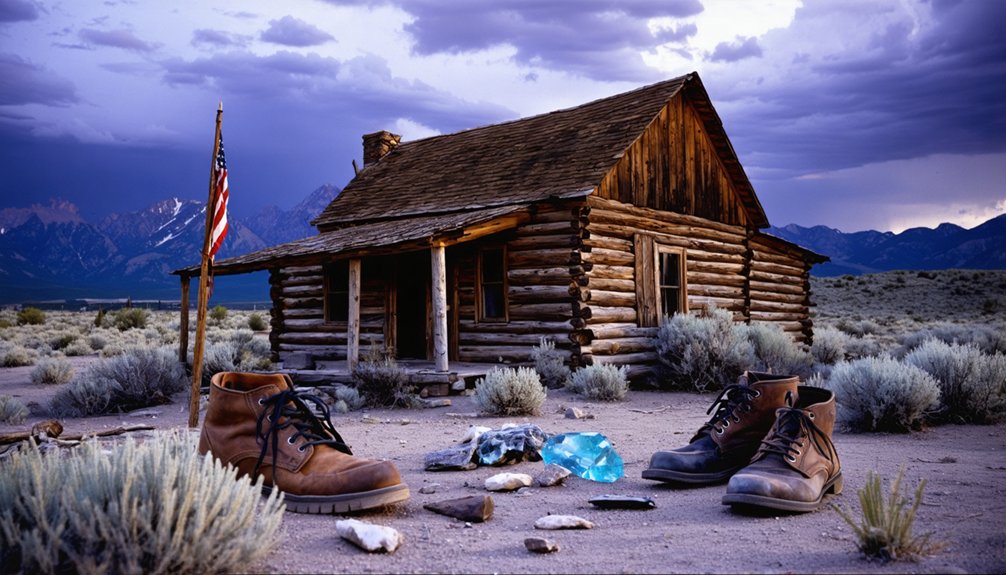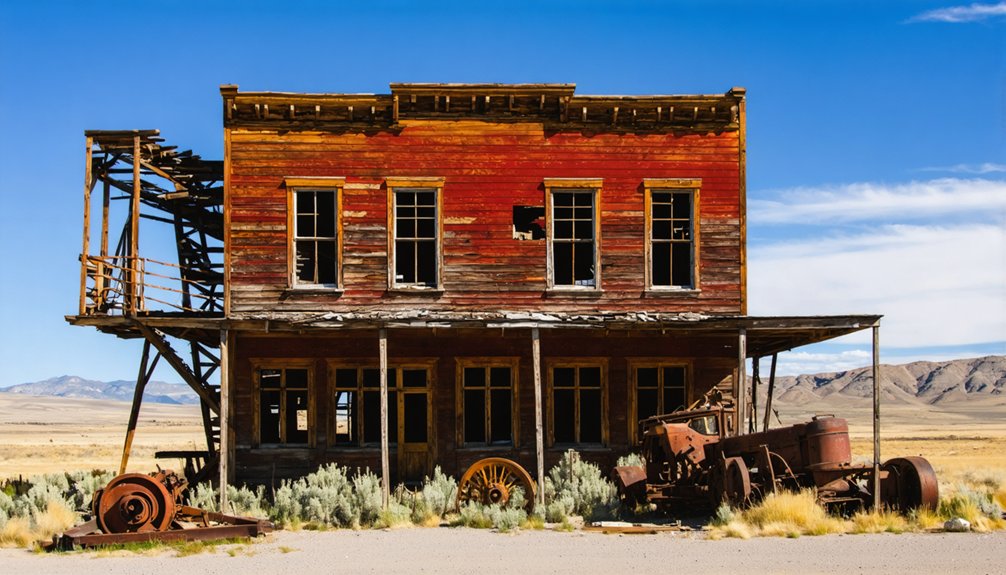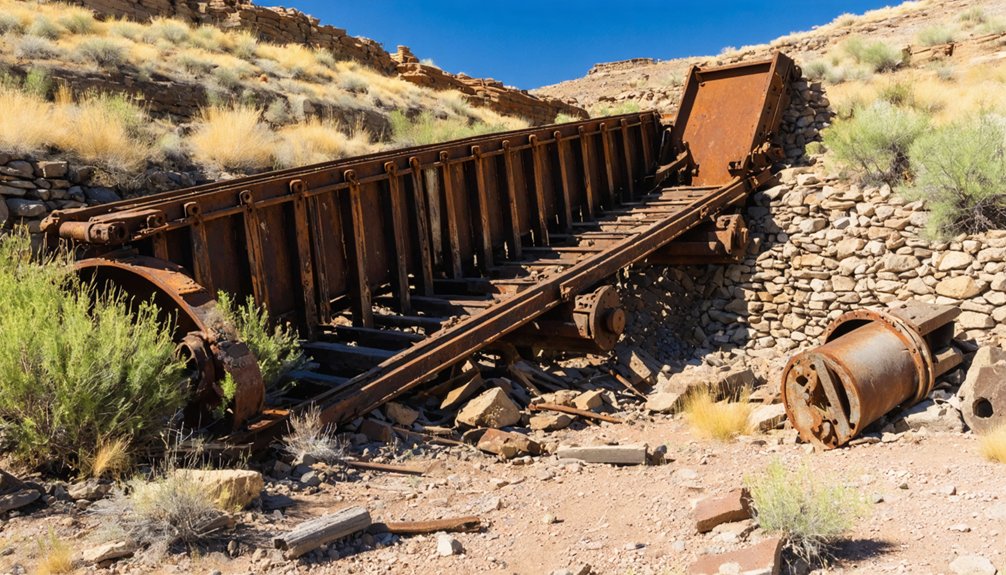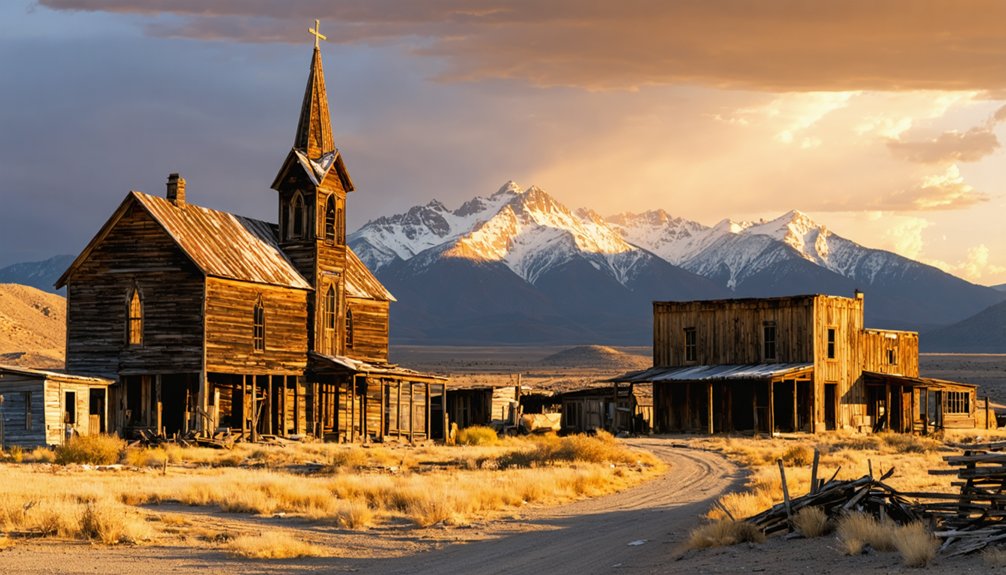You’ll find Flint nestled at 7,000 feet in Idaho’s rugged Owyhee Mountains, where silver’s discovery in 1863 sparked a mining boom. The Rising Star Mine and others yielded over 20 million ounces of silver before economic struggles and harsh conditions led to its abandonment by the early 1900s. Today, this privately-owned ghost town requires explicit permission to visit, with its weathered structures and mining remnants telling tales of frontier perseverance that run far deeper than their thousand-foot shafts.
Key Takeaways
- Flint is a privately-owned ghost town in Idaho that emerged from silver discoveries in 1863 and required explicit permission for visitation.
- The town produced over 1.5 million ounces of silver at 20-30 ounces per ton before becoming abandoned by early 1900s.
- Located at high elevations between 4,700-8,400 feet, Flint faced harsh weather conditions that challenged mining operations and daily life.
- Major mines including Rising Star, Perseverance, and Silver Queen operated tunnels exceeding 1,000 feet deep along mineral-rich veins.
- Community life centered around saloons, the post office, and mill, with only one permanent resident remaining during winter months today.
The Rise of a Mining Frontier Town
When prospectors discovered silver in 1863 near what would become Flint, Idaho, they sparked the birth of one of the region’s most productive mining frontiers.
Claims were typically staked in dimensions of 200 feet long along discovered veins.
You’ll find the Rising Star Mine among the first major discoveries in 1865, followed by other notable operations like the Perseverance, Iva Grace, and Silver Queen.
The real mining boom kicked off in 1889 with the discovery of the rich Black Jack and De Lamar ore bodies.
The Black Jack and De Lamar discoveries in 1889 ignited an unprecedented silver rush that transformed Idaho’s mining landscape forever.
The district’s historical significance stems from its incredible output – over 1.5 million ounces of silver at exceptional grades of 20-30 ounces per ton.
You’re looking at an area that became Idaho’s second-most productive mining region, yielding more than 1,000,000 ounces of gold and 20,000,000 ounces of silver, surpassed only by the Coeur d’Alene district.
Today, the Flint project consists of 130 mining claims spanning across the historic district.
Life at 7,000 Feet: Geography and Climate
The rugged terrain of Flint presented unique challenges to the miners who sought their fortunes in its rich ore deposits.
Living at high elevation meant adapting to harsh weather patterns and thin air, where oxygen levels tested even the heartiest settlers. To ensure safety and prevent unauthorized access, the mining company implemented strict identity verification processes. Situated in Power County’s challenging landscape, you’d find yourself maneuvering elevations from 4,700 feet near Flint Canyon to 8,400 feet at Hayden Peak. Most precipitation in the region falls as winter snowpack, creating hazardous conditions for mining operations.
Life at these heights brought distinct obstacles:
- Limited growing seasons made food cultivation a constant struggle
- Extreme temperature swings demanded resilient building techniques
- Wind-swept slopes increased erosion risks and structural challenges
- Transportation difficulties isolated the community during severe weather
These environmental factors shaped the daily lives of Flint’s inhabitants, requiring them to develop innovative survival strategies in this unforgiving mountain setting.
Mining Operations and Technical Challenges
Mining operations in Flint centered around an intricate network of claims, typically parceled into 200-by-100-foot lots that stretched up to 2,200 feet along silver-rich veins.
You’d find miners driving tunnels and shafts over 1,000 feet deep through the Silver City granite and rhyolite formations, where they’d encounter bonanza-grade deposits yielding 20-30 ounces of silver per ton.
The mining techniques weren’t simple – ore extraction faced significant challenges due to complex mineralogy.
You’d see crews wrestling with zinc and antimony-rich ores that complicated recovery processes.
The refractory nature of the ore, combined with high levels of manganese, copper, lead, cobalt, and nickel, demanded specialized processing methods.
To combat these issues, operations required constant adaptation of technology and precise geological mapping for selective stoping.
Located at an elevation of 6,401 feet, the mine’s high altitude posed additional logistical challenges for equipment and personnel.
The area’s rich mineral deposits contributed to a remarkable historical production exceeding 1,000,000 ounces of gold and 20,000,000 ounces of silver throughout the Silver City region.
Daily Life in a Remote Mountain Settlement
You’d find daily life in Flint centered around grueling mining work, where residents endured harsh mountain conditions and isolation from larger settlements.
Your social life would revolve around the town’s saloons, which served as essential gathering spots for miners seeking relief from their demanding jobs and remote living conditions. Living in the mountains meant dealing with harsh weather conditions throughout the year.
You’d need to stay vigilant against threats from local Native American groups and wildfires, which created ongoing safety concerns for the settlement’s 1,500 inhabitants. The town’s only permanent resident now watches over the historic buildings in complete solitude during winter months.
Mining Life Hardships
Life in Flint’s remote mountain settlement tested even the hardiest souls, as miners faced brutal environmental challenges while pursuing silver riches in Idaho’s rugged terrain.
Historical surveys by Piper and Laney documented the extreme conditions miners endured in this unforgiving landscape.
For those exploring this mining heritage today, you’ll find remnants of a harsh existence where survival demanded extraordinary grit.
Your ghost town exploration reveals the daily struggles these pioneers endured:
- You’d spend grueling hours underground, battling dust and toxic metals while risking cave-ins and explosions.
- Your cramped log cabin offered little protection from bitter mountain winters and severe storms.
- You’d haul water from distant sources or melt snow, straining already limited energy.
- Your isolation meant limited access to medical care, while basic supplies remained scarce and expensive.
The demanding conditions ultimately contributed to Flint’s abandonment, leaving behind silent testimony to mining life’s unforgiving nature.
Community Safety Concerns
While exploring the remote mountain settlement of Flint today, you’ll encounter numerous safety challenges that mirror those faced by its original inhabitants.
You’ll need to navigate poorly maintained access roads, often barely wide enough for vehicles, with brush and branches that can damage your paint. Like the abandoned boomtowns throughout Idaho’s mining history, the mountainous terrain masks potential dangers from wildlife and weather, while abandoned mines present hazards from unstable structures and open shafts.
Without nearby emergency services or reliable communication coverage, you must rely on self-sufficiency and community trust. Following strict safety protocols becomes essential – from carrying emergency supplies to respecting private property laws.
The area’s isolation, combined with limited infrastructure and harsh conditions, demands careful planning and awareness, especially given the 10-mile distance from Silver City’s relatively better-equipped facilities.
Social Gathering Spots
Despite its remote mountain setting, Flint’s social fabric centered around several key gathering spots that defined daily life in the settlement. You’d find most social interactions occurring at the local saloons, where music and storytelling brought the community together after long workdays.
The post office and general stores weren’t just places for business – they served as vibrant hubs for exchanging news and strengthening community bonds.
Key community events and daily gatherings typically occurred at:
- The mill, where workers shared breaks and daily updates
- Multiple saloons offering entertainment and relaxation
- The livery stable, mixing business with social connection
- The post office, linking residents through mail and conversation
These locations provided essential spaces for maintaining community spirit while staying vigilant against external threats.
The Rising Star Mine Legacy
The Rising Star Mine emerged as a significant player in Idaho’s mining history when George Hearst and his San Francisco associates purchased it in December 1867, just two years after its discovery.
You’ll find this historic mine perched on Black Warrior Mountain’s western slope in the Flint Mining District, where it’s surrounded by the rugged terrain of Astor and Twilight gulches.
Despite its promising silver and gold deposits, the Rising Star faced unique challenges. The presence of zinc and antimony in the ore made processing difficult, ultimately leading to financial struggles.
Today, while you can’t access the mine due to private ownership, its historical contributions to Owyhee County’s economy and Idaho’s mineral legacy remain significant, serving as a reflection of the region’s rich mining heritage alongside neighboring sites like Silver City.
Native American Relations and Security

As miners flooded into the Flint Mining District during the 1860s, relations between Euro-American settlers and Native American tribes shifted dramatically from initial peaceful interactions to mounting tensions.
Historical interactions that once centered around Council Valley’s vibrant tribal gatherings gave way to Native grievances over Treaty violations and forced displacement.
- Traditional gathering grounds became mining claims, disrupting centuries-old cultural practices
- The Nez Perce War of 1877 erupted after settlers illegally occupied tribal lands
- Shoshone territories shrank from 1.8 million acres to a fraction of their original size
Despite challenges, Native communities demonstrated cultural resilience by adapting while maintaining their identity.
In the Flint area, like elsewhere across Idaho, the discovery of minerals tragically transformed peaceful coexistence into a struggle for tribal survival against expanding settlement and resource exploitation.
Transportation and Accessibility Challenges
Located approximately 10 miles southwest of Silver City, Flint’s challenging terrain and remote location created significant transportation hurdles throughout its history.
You’ll find the main access required following Long Gulch to the top, then turning south along an old stagecoach route marked by fence lines.
The remote logistics of supplying this mining town were intimidating. You’d need to navigate creek crossings, steep rocky trails, and seasonal weather challenges that often made routes impassable.
Without railroads or maintained roads, residents relied on pack animals and foot travel for goods and mail delivery.
Today, you can’t reach Flint by standard vehicle – you’ll need an ATV, mountain bike, or hiking boots to traverse the rugged terrain.
The round trip from Silver City spans 26 miles, and you must be entirely self-sufficient.
Economic Struggles and Eventual Abandonment

You’ll find that Flint’s mining operations struggled with profitability as ore deposits became increasingly depleted and processing costs rose beyond sustainable levels.
The town’s primary mine went bankrupt in the late 1890s, leaving hundreds of workers without income and forcing local businesses to shutter.
As economic opportunities vanished, Flint’s population rapidly dwindled until the town was completely abandoned by the early 1900s.
Mining Challenges Doomed Profits
Despite promising initial discoveries of gold and silver deposits, Flint’s mining operations faced devastating economic challenges that ultimately sealed the town’s fate. The presence of zinc and antimony in silver ores created severe mining profitability challenges, while complex mineralogy resulted in ore extraction inefficiencies that plagued operations from the start.
Key factors that doomed Flint’s mining ventures:
- Poor road conditions made transporting ore prohibitively expensive
- Harsh winters and seasonal limitations reduced annual production
- Equipment wore out quickly due to mineral impurities in the ore
- Fluctuating metal prices couldn’t offset the high processing costs
These obstacles, combined with the mass exodus of experienced miners to more profitable districts, created an unsustainable cycle of bankruptcy and ownership turnover that eventually forced Flint’s mines to close permanently.
Ore Processing Issues Persisted
While Flint’s mining ventures showed early promise, persistent ore processing challenges throughout the 1880s and 1890s severely hampered the town’s economic viability.
You’d have found inadequate infrastructure and outdated technological advancements that couldn’t efficiently process the extracted ores. The remote location made it difficult to transport heavy machinery and maintain consistent operations.
Weather conditions and unreliable water supplies further complicated ore processing efforts, while rising production costs cut into already slim profit margins.
As metal prices fluctuated, you couldn’t count on steady returns from processed minerals. The lack of significant investment in upgrading facilities meant the town couldn’t keep pace with competing mining operations elsewhere in Idaho.
These processing limitations, combined with increased regulatory pressures and environmental concerns, ultimately pushed Flint’s mining operations past the point of profitability.
Population Exodus After Bankruptcy
The accumulation of ore processing difficulties ultimately led to devastating financial consequences for Flint’s mining operations in the late 1890s.
As mining activities dwindled, you’d have witnessed a dramatic population decline from 1,500 residents to nearly zero. The economic shift proved particularly harsh as Flint’s single-industry economy couldn’t adapt to changing circumstances.
Key impacts of the exodus included:
- Closure of essential businesses including the post office and livery stable
- Abandonment of residential structures as families sought opportunities elsewhere
- Deterioration of local infrastructure without maintenance
- Loss of community services and social cohesion
The town’s rapid descent into ghost town status serves as a stark reminder of how quickly fortunes can change when a community relies too heavily on a single industry for survival.
Preserving Flint’s Mining Heritage Today

In recent decades, preservation efforts at Flint’s historic mining site have focused on protecting and interpreting its rich 19th-century heritage.
You’ll find carefully stabilized structures like the Rising Star Mine ore-concentrating mill, where heritage conservation teams use compatible materials to maintain historical authenticity. Public engagement happens through guided tours, interpretive signage, and digital resources that bring Flint’s story to life.
The site’s preservation aligns with state and federal standards, allowing access to grants and technical support. You can explore oral histories from long-time residents, examine historical photographs at local museums, and participate in heritage days that celebrate Flint’s mining legacy.
Through partnerships with agencies like the Bureau of Land Management, ongoing efforts guarantee this remarkable ghost town remains a monument to Idaho’s mining history.
Private Ownership and Access Restrictions
If you’re planning to visit Flint’s ghost town ruins in Owyhee County, you’ll need to know that the site is privately owned and requires formal permission for entry.
You must respect the posted property boundaries and signs, as trespassing can result in legal consequences under Idaho law.
While the surrounding area offers hiking and ATV trails, your access to the historical structures and cemetery is strictly controlled by the property owners’ discretion.
Current Ownership Status
Situated among Idaho’s rugged terrain, Flint stands as a privately-owned ghost town that’s remained under the same family’s control since the 1800s. This ownership continuity has preserved the site’s authenticity while maintaining strict control over access and usage.
Unlike many other ghost towns with disputed claims, Flint’s legal status remains clear and unambiguous.
You’ll find these key aspects of Flint’s current ownership:
- Private property signs and gates clearly mark the boundaries, reflecting active management by resident landowners
- No public or governmental entities have administrative rights over the land or structures
- Legal implications of trespassing are significant under Idaho’s stricter 2018 laws
- Historical mining structures and ruins remain under private stewardship, limiting unauthorized exploration
Access Permission Requirements
Accessing Flint’s historic ghost town requires explicit permission from the private landowners, who maintain strict control over the site’s visitation.
You’ll need to secure landowner permissions before exploring the area, as the entire site sits on private property. Access agreements must be obtained not only for the ghost town itself but also for crossing any private lands leading to the site.
When visiting, you’re required to follow designated trails and marked routes to protect both the environment and historical structures.
You can reach the site via hiking, mountain biking, or ATV trails near Silver City, but remember that motorized vehicle access may be restricted due to fire management policies.
Current fire conditions and restrictions should be checked before planning your visit, as they’ll affect your access options.
Trespassing Law Implications
Despite its historical allure, Flint’s ghost town remains under strict private property protection, making unauthorized entry a serious legal offense under Idaho law.
If you’re planning to explore this fascinating site, you’ll need to understand the trespassing consequences and legal liabilities that could affect you.
- You don’t need to see “No Trespassing” signs to be held liable – Idaho law protects private property regardless of signage.
- You’re facing potential misdemeanor charges and fines if caught on the property without permission.
- Your social media posts or photos can be used as evidence against you in legal proceedings.
- You’ll risk increased penalties for repeat offenses under Idaho statutes.
The law applies equally whether you’re interested in the cemetery, old mill, or frame houses – all require explicit owner permission for access.
Frequently Asked Questions
Were Any Notable Crimes or Murders Committed in Flint During Its Peak?
You won’t find documented evidence of specific murders, though there were likely mysterious disappearances and unsolved cases during settler-Native American conflicts, but historical records don’t preserve these details.
What Happened to the Mining Equipment After the Town Was Abandoned?
You’ll find most mining equipment was left to decay on-site after abandonment, with some pieces possibly salvaged by private owners. Historical preservation efforts haven’t fully documented what remained at Flint.
Did Any Famous People Ever Visit or Live in Flint?
Like a hidden treasure chest waiting to be discovered, you won’t find any famous visitors or historical figures in Flint’s records. No celebrities or notable personalities ever called this mining town home.
What Was the Average Life Expectancy of Flint’s Residents?
You’d have faced tough health conditions in Flint, with a life expectancy between 35-45 years due to mining hazards, limited medical care, harsh winters, Indian conflicts, and diseases common in 1800s frontier towns.
Were There Any Significant Natural Disasters That Affected the Town?
Despite 100+ years of history, you won’t find records of any major natural disasters striking the area. While harsh mountain weather and environmental challenges existed, no natural events caused significant disaster impact.
References
- https://pinintheatlas.com/travel-blogs/ghost-towns-of-idaho/
- https://history.idaho.gov/wp-content/uploads/2018/08/0064.pdf
- https://www.idahomagazine.com/article/war-eagle-mountain-mining-idaho/
- https://idaho-forged.com/idahos-ghost-towns-eerie-yet-approachable/
- https://www.ghosttowns.com/states/id/flint.html
- https://www.youtube.com/watch?v=rTSZSlxTmbs
- https://visitidaho.org/things-to-do/ghost-towns-mining-history/
- http://granitecountyhistory.blogspot.com/2013/06/the-flint-creek-mining-district-in-1866.html
- https://headwatergold.com/2022/headwater-gold-re-acquires-the-flint-project-adjacent-to-the-delamar-project-idaho/
- https://westernmininghistory.com/library/38233/page1/



